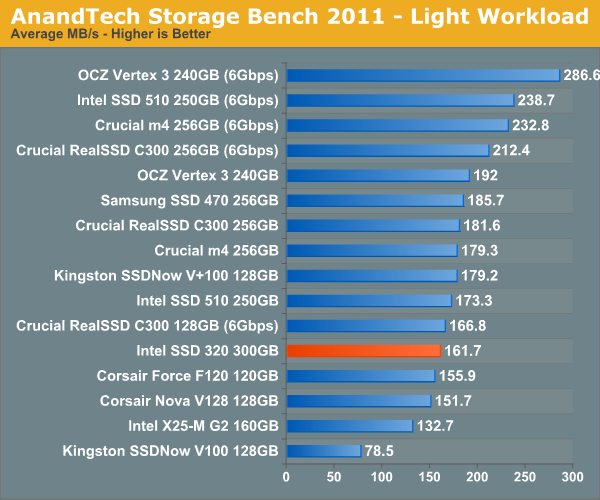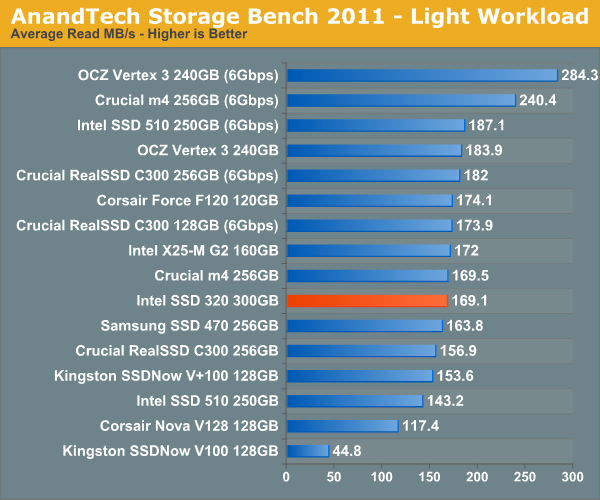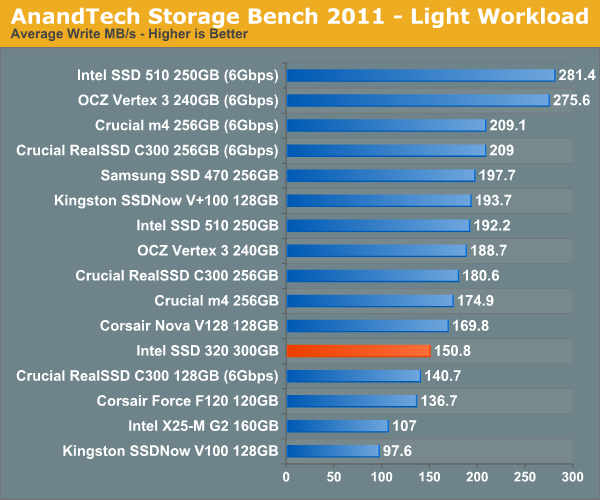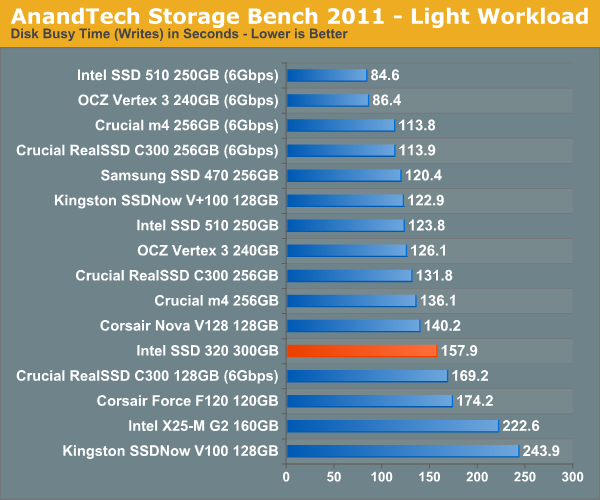The Intel SSD 320 Review: 25nm G3 is Finally Here
by Anand Lal Shimpi on March 28, 2011 11:08 AM EST- Posted in
- IT Computing
- Storage
- SSDs
- Intel
- Intel SSD 320
AnandTech Storage Bench 2011 - Light Workload
The 320 doesn't do bad for a 3Gbps drive, it's a bit faster than the SF-1200 based Corsair Force F120 but it's slower than Intel's SSD 510 and definitely slower than the upcoming Vertex 3.
















194 Comments
View All Comments
bji - Tuesday, March 29, 2011 - link
I think that garbage collection refers to a process of deferring block erases to a later time to be done when the drive is otherwise idle. I.e., if you need to rewrite a block you don't re-write it in place, you write it to a block from the spare area that is already cleared thus saving yourself the time of having to erase the old block before rewriting it. You still mark the old block as needing to be cleared and put into the spare area (to replace the block that was taken out of the spare area during this process), and you do that later during 'garbage collection'.There may also be some aspects to which individual blocks from an erase region (my understanding of the terminology is a bit off but I am pretty sure that flash memory can write to smaller regions than it can erase) are moved around during 'garbage collection' to consolidate them into single blocks; this takes blocks that are interspersed with dead area and collapses them down to a smaller fully populated region, then takes all of the now-free blocks and then erases them and puts them in the spare area.
Having TRIM makes both of these processes more efficient because it tells the drive that it can just mark blocks as ready-for-erase-and-put-into-the-spare-area immediately rather than having to be tracked and managed, and also increases the overall spare area available which means that more already-erased blocks are ready to be used for writes. Having to erase a block before writing it is the performance killer of SSDs and TRIM, along with intelligent algorithms listed above, in addition to things I haven't even thought of most likely, are what allow SSDs to get around the erase block performance penalty and to have such killer performance.
randomlinh - Monday, March 28, 2011 - link
I was excited to see this back when it was "announced." I was hoping we'd be closer to $1/GB for the mainstream performance around now, but looks like I've still got to wait.Hoping the 2011 round of controllers push intel to compete with pricing. I'm happy with the performance honestly, but need pricing.
Or maybe this will drive the x25-Ms down in price and I'll just RAID-0 a pair of 80GB's...
Ushio01 - Monday, March 28, 2011 - link
So all we get from Marvel and Intel are there old controllers working as they should of from the beginning with only Sandforce actually innovating, pathetic.darckhart - Monday, March 28, 2011 - link
"should have been" maybe. but we all know that's not how business works. sell it, revise it, sell it, revise it, ad nauseum. in any case, know this: they are getting comparable SF-12xx performance WITHOUT realtime compression and dedup which is mighty impressive in my book.darckhart - Monday, March 28, 2011 - link
oh i forgot to mention they're doing this on 25nm.Vlad T. - Monday, March 28, 2011 - link
Planned obsolescence or built-in obsolescence.http://en.wikipedia.org/wiki/Planned_obsolescence
That is even more obvious considering how Intel trashes G2 with the same controller.
thudo - Monday, March 28, 2011 - link
My gawd how the mighty have fallen? Doesn't remotely hold its own against the mighty Vertex 3 (SATA3). 120Gb Vertex 3 as now showing up in Canada for ~$290 -- a frick'n steal considering my boot drives have always been ~100-150Gb+ (all you need) and the performance increase is so well worth it. Shame Intel.. shame..davepermen - Monday, March 28, 2011 - link
you know that intel has the 520 ssds, too? those are to fight vertex3.not that i would ever consider ocz an ssd worth buying anyways, but lets not discuss that. anand loves them after he hated them. i still can't (as even after anand has forgiven them, they continue the same crap they did before).
so for a sata3 system, it's 520. for a sata2 system, the 320 is fine, actually nearly perfect.
sean.crees - Tuesday, March 29, 2011 - link
Say what you will of OCZ, at least they listen to their consumers, and attempt to make legitimate changes in their business practices to satisfy their existing customer base.Intel has it's advantages, but appeasing it's current customers are not one of them. Ask the numerous amounts of people that jumped on Intel's 1st gen SSD bandwagon to then be shunned from TRIM support forever, which would require nothing but a firmware upgrade. 2x 80gb for $500 each, and no TRIM support. These things have slowed to almost HDD performance.
shatteredx - Monday, March 28, 2011 - link
Performance is fine, but Intel isn't pricing these drives cheaply enough.Whatever happened to the prediction that 25nm drives would cost half as much as their 34nm siblings?